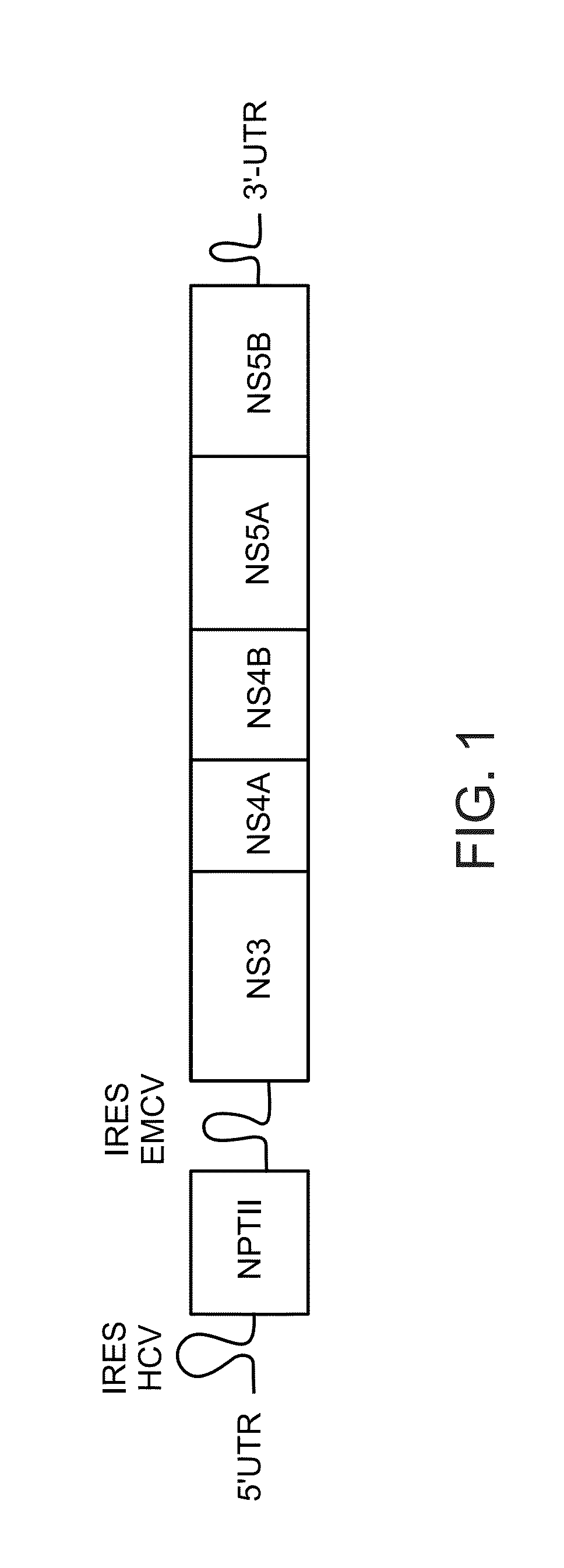Treatment of hepatitis c virus related diseases using hydroxychloroquine or a combination of hydroxychloroquine and an Anti-viral agent
a technology of hepatitis c virus and hydroxychloroquine, which is applied in the field of treatment, can solve the problems of recurrent and progressively worsening liver inflammation, limited success rate of this combined therapy, and reduced viral ra
- Summary
- Abstract
- Description
- Claims
- Application Information
AI Technical Summary
Benefits of technology
Problems solved by technology
Method used
Image
Examples
example 1
Effect of Hydroxychloroquine in Combination with Interferon-α on HCV RNA Replication
[0487]Huh7 cells were treated with various concentrations (0, 0.22, 0.66, 2, 8 and 18 μM) of hydroxychloroquine sulfate (HCQ) in combination with various concentrations (0, 0.41, 1.23, 3.7, 11.1, 33.3, 100 and 300 IU / ml) of PEGylated to human interferon-α (Peginterferon alfa-2b), as described hereinabove. The levels of HCV RNA were measured by RT-PCR, and the results were analyzed according to Prichard-Shipman, Chou-Talalay and isobologram models, as described hereinabove. In addition, cytotoxicity of the tested combinations of HCQ and interferon-α (IFNα) was determined as described hereinabove.
[0488]As shown in FIG. 2, HCQ and IFNα each inhibited HCV RNA replication in a dose dependent manner, both alone and in combination.
[0489]As shown in FIGS. 3A and 3B, HCQ and IFNα exhibited a synergistic effect in combination, as determined according to a Prichard-Shipman model. The synergistic effect was part...
example 2
Mechanistic Insights
[0499]Effect of Hydroxychloroquine on NF-κB Signaling in HCV Replicon Cells:
[0500]The Huh7 harboring replicon model was used to assess the effect of hydroxychloroquine (HCQ) on HCV infection.
[0501]In one set of experiments, HCV replicon-Huh-7 / neo cells were seeded in 96-well plate for 16 hours. Then cells were incubated with several concentrations of HCQ for 72 hours. Replication levels of HCV replicon were determined by quantification of a replicon-borne neomycin gene product (NPT II, % NPTII). Data is presented in FIG. 7. Bars represent the mean of duplicate wells expressed as percentages compared to the control cells, errors indicate standard deviation (SD). Differences were compared for the HCQ-treated conditions to the corresponding untreated one using a Student t-test. Basically p-values less than 0.05 were considered as statistically significant and are represented by an asterisk (*).
[0502]In another set of experiments, Huh7 cells harboring HCV replicon we...
example 3
Effect of Hydroxychloroquine in Combination with Polymerase and Protease Inhibitors On HCV RNA Replication
[0574]Huh7 cells were treated with various concentrations (0, 0.22, 0.66, 2, 6 and 18 μM) of hydroxychloroquine sulfate (HCQ) in combination with various concentrations of the antiviral agents NM-107 and boceprevir, in order to determine whether the combinations exhibit synergy. The procedures were similar to those described in Example 1 for HCQ+IFN combinations.
[0575]NM-107 is a viral polymerase inhibitor. It is more commonly utilized in a prodrug form (valopicitabine is a prodrug of NM-107) than as a drug. Boceprevir is a viral protease inhibitor. Thus, these two compounds represent different families of antiviral agents, both in respect to one another and in respect to IFN.
[0576]0, 0.11, 0.33, 1, 3 and 9 μM NM-107 was combined with HCQ, as was 0, 0.041, 0.123, 0.37, 1.1, 3.3 and 10 μM boceprevir. HCV RNA were measured by RT-PCR, and the results were analyzed according to a Pr...
PUM
| Property | Measurement | Unit |
|---|---|---|
| Mass | aaaaa | aaaaa |
| Mass flow rate | aaaaa | aaaaa |
| Mass flow rate | aaaaa | aaaaa |
Abstract
Description
Claims
Application Information
 Login to View More
Login to View More - R&D Engineer
- R&D Manager
- IP Professional
- Industry Leading Data Capabilities
- Powerful AI technology
- Patent DNA Extraction
Browse by: Latest US Patents, China's latest patents, Technical Efficacy Thesaurus, Application Domain, Technology Topic, Popular Technical Reports.
© 2024 PatSnap. All rights reserved.Legal|Privacy policy|Modern Slavery Act Transparency Statement|Sitemap|About US| Contact US: help@patsnap.com










